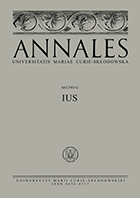Funkcja ochronna prawa pracy na przykładach wybranych regulacji państw europejskich
The Protective Function of Labour Law Regulations on Examples of Selected European Countries
Author(s): Maciej JarotaSubject(s): Supranational / Global Economy, Civil Law, Labor relations, Human Resources in Economy
Published by: Wydawnictwo Naukowe Uniwersytetu Marii Curie-Sklodowskiej
Keywords: protective function; labour law; annual leave; adolescents; children; termination; years of service;
Summary/Abstract: The protective function of labour law is the most important feature of the employment relationship stemming from both labor law standards encoded in the provisions of normative acts, as well as the specific mechanism of their interaction. In Europe, the protective function of labour law is defined as the regulations and mechanisms privilege of remaining in employment, particularly in view of the factual situation in which they are located, for example age (the so called Protection law) and legal structures which boil down to prevent unjustified solve employment contract with the employee by the employer (the so-called job security). The study focuses on the presentation of three planes carrying out protective function of labour law: the right of workers to leave; protection of individuals under the age of 18 years performing work; the legal status of an employee, which the employer intends to terminate the employment contract by notice limited to the presentation of selected institutions: Greece, Spain, Latvia, Germany, Sweden, Great Britain and Italy.
Journal: Annales Universitatis Mariae Curie-Skłodowska, sectio G – Ius
- Issue Year: 62/2015
- Issue No: 2
- Page Range: 67-77
- Page Count: 11
- Language: Polish

